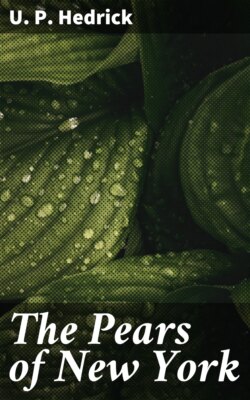Читать книгу The Pears of New York - U. P. Hedrick - Страница 37
На сайте Литреса книга снята с продажи.
ANSAULT
ОглавлениеTable of Contents
1. Am. Pom. Soc. Cat. 36. 1883. 2. Can. Hort. 24:454, fig. 2169. 1901.
Bonne du Puits-Ansault. 3. Leroy Dict. Pom. 1:486, fig. 1867. 4. Downing Fr. Trees Am. 1st App. 123, fig. 1872. 5. Am. Pom. Soc. Cat. 34. 1877.
Well grown, the fruits of Ansault rival those of Seckel in quality. In particular, the flesh is notable, and is described by the term buttery, so common in pear parlance, rather better than that of any other pear. The rich sweet flavor, and distinct but delicate perfume contribute to make the fruits of highest quality. Unfortunately, the pears are not very attractive in appearance. They are small, and the green coat, nearly covered with russet dots and markings, is dull, though enlivened somewhat at full maturity by a rich yellow. The tree in good pear soils is vigorous, productive, bears annually, and is not more subject to blight than that of the average variety. While not at all suitable for commercial orchards, Ansault should find a place in every collection of pears for home use.
The pear Bonne du Puits-Ansault was raised from seed in the nurseries of M. André Leroy, Angers, France. The parent tree bore fruit in 1863, and M. Leroy states that the name which it bears is that of the enclosure where it was first raised. It was propagated in 1865. The American Pomological Society first listed this variety in its catalog in 1877, and in 1883 shortened the name to its present form.
Tree large, upright-spreading, hardy, very productive; trunk stocky, shaggy; branches thick, dull brownish-red, tinged with green and heavily covered with greenish scarf-skin, with numerous raised lenticels; branchlets long, reddish-brown, with traces of gray scarf-skin, smooth, glabrous, with few inconspicuous, small, slightly raised lenticels.
Leaf-buds plump, pointed, nearly free. Leaf-scars prominent. Leaves numerous, 2¾ in. long, 1½ in. wide, ovate or broadly oval, leathery; apex abruptly pointed; margin finely serrate, with small, reddish, sharp-pointed glands; petiole 1½ in. long, slender, glabrous. Fruit-buds large, conical, plump, free; flowers 1⅛ in. across, in dense clusters, 7 to 9 flowers in a cluster; pedicels ⅝ in. long, thick, greenish, lightly pubescent.
Fruit ripe in late September and early October; medium in size, 2⅜ in. long, 2⅛ in. wide, uniform, obtuse-obovate-pyriform, irregular; stem ⅝ in. long, short, thick; cavity obtuse, russeted, furrowed, ribbed; calyx partly open, large; lobes acute; basin somewhat abrupt, furrowed and wrinkled; skin roughened with russet markings and dots; color pale yellow, considerably russeted about the basin and cavity with russet dots, with scattered flecks and patches of russet; dots numerous, small, russet; flesh tinged with yellow, granular at the center, melting and tender, buttery, very juicy, sweet, aromatic; quality good to very good. Core closed, axile, the core-lines clasping; calyx-tube long, narrow, funnel-shaped; seeds rather short, plump, obtuse.
